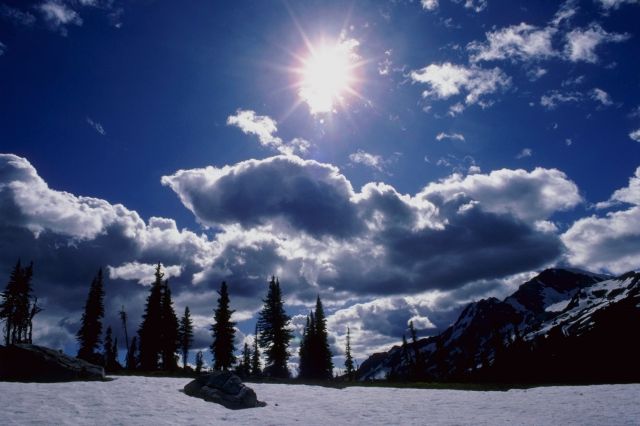

Auroras, or northern lights, are made up of charged particles that are about 60 miles above the earth on average. The lower edge may be as low as forty miles, but the upper limit extends more than twice that height. The most common colors are blue and green, although sometimes reds are seen as charged particles interact with gases in the earths magnetosphere. The process is very similar to that of a neon sign which contains a gas (neon) through which electrical charges are passed in order to make it glow.Auroras occur year round, but are most visible during the fall and spring months on dark, clear nights. They are seen in cycles that repeat on an approximately eleven (11) year basis, with the next peak due to occur in about 2000-2001. This is based on the eleven year cycle of sun spot activity. There was an especially beautiful and long lasting aurora in November 1998, and again in October 1999. We can expect to see more of them as this winter (1999) progresses. Auroral displays typically last about an hour, with a period of low activity followed by another display later in the night. This can repeat several times during an active season. Sometimes the aurora is seen as early as seven o'clock p.m., and continues non-stop through the night until the sun beings to rise in the morning.
Auroras also follow a shorter cycle. When there is a series of particularly intense auroral activity, look for a repeat of the activity 27 days later. This is because the period of rotation of the sun is 27 days. That is, one solar day is equal to 27 earth days. This means that the point on the sun where the sunspot activity was greatest (more sunspots means more auroras) will once again face the earth 27 days later. Another cycle may occur which is much longer then the 11 year cycle. When auroral activity is plotted over many decades it is evident that each peak eleven year period has been a lower level of activity then the previous one since the mid 1950's. Unfortunately, the records do not go back far enough to clearly indicate the period of this cycle, but it appears to be on the order of about 80 years. Expect very intense displays again in the 2030-2035 period!
 More aurora info, with photos!
More aurora info, with photos!
 Aurora activity predictor
Aurora activity predictor
The most famous earthquake in Alaska occurred at 5:36 p.m. on Good Friday, March 27, 1964. Although it was originally estimated to have a magnitude
of 8.6 on the Richter Scale, that was later upgraded to a
9.2, the largest earthquake to ever occur in the United States. It lasted a full five minutes, unlike most earthquakes which last about 30 seconds or less.
One side of the street in downtown Anchorage dropped ten feet, and there were 115 deaths attributed to this earthquake. The number of deaths was relatively small
because most people were home at the time and there was not a large population in the area.
A tsunami is a large wave caused by an earthquake which may be as large as 200 feet high. Coastal cities in south Alaska did experience tsunamis from this earthquake, but Anchorage was too far inland to experience significant damage from waves.
The largest wave on record was a seiche wave, caused by a 3,000 foot high section of a mountain that fell into Lituya Bay due to an earthquake on July 9, 1958. The resulting wave was 1,740 feet high and uprooted trees half way up the mountain on other side of the bay.
Earthquake reports are usually stated in 24-hour UTC time, which uses Greenwich, England, as the reference point. As a result we need to compensate for the stated times of the earthquake to know the local Alaska time. Subtract 9 hours for standard time (end of October to beginning of April), or 8 hours for daylight time (April through October). For example If the stated time for an earthquake is 16:45, that is 4:45 p.m. in England, and (between October and April) it is 7:45 a.m. Alaska time.
On November 3, 2002 there was a 7.9 magnitude earthquake centered just 45 ENE of Cantwell, near Denali NP. It ocurred at 1:12 p.m., on a Sunday afternoon and was felt all over the state. That is the largest magnitude earthquake along that particular fault line since 1912.
(Near) Real-Time earthquake report
![]() Check out the last 100 earthquakes!
Check out the last 100 earthquakes!
Alaska has many volcanoes which is not unexpected given their association with siesmic phenomena, and the large number of earthquakes that occur here. Most of the volcanoes are along the Aleution chain, however there are several in the Cook Inlet area, not far from Anchorage. The following is a list of the most important of those volcanoes.
The most recent significant volcanic eruption occurred on the Aleutian chain at Unimak Island on May 27, 1999. Mt. Shishaldin spewed an ash plume to 45,000 feet above sea level. It has quieted considerably since then.
![]() Chena Hot Springs
Chena Hot Springs
![]() Manley Hot Springs
Manley Hot Springs

RAINBOWS AND SUN DOGS!!
© Established September 1999 - Clyde E. Pearce